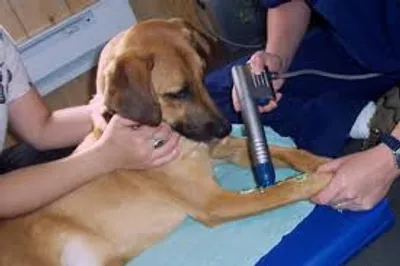Shockwave For Pets
Our Most Exciting Addition Yet . . . Now Offering Shock Wave Therapy!
Shockwave for pets
Shock waves are high-energy focused sound waves generated outside the body that can be focused at a specific site within the body. Extracorporeal shock wave therapy (ESWT) has been used in human medicine for over 25 years to break up kidney stones and gallstones (lithotripsy) without the need for invasive surgery. In 1992, doctors began using shock waves to treat a range of orthopedic conditions, including non-union of bone fractures, plantar fasciitis, tennis elbow, rotator cuff injuries and joint pain. By the late 1990s, veterinarians began exploring the use of ESWT on horses to speed healing of broken bones, tendon and ligament injuries, and ease the pain of arthritis. Experimental treatment of dogs using ESWT began in 1999, and several major university veterinary schools have been actively involved in this research. Good results have been reported for treatment of various orthopedic conditions in dogs, but the number of controlled clinical studies is still very limited.
How does shockwave therapy for pets work?
The machine generates a series of focused high-pressure acoustic pulses (sound waves) that travel from the probe through the skin and soft tissue. When the waves meet tissue interfaces of different densities, such as where soft tissue, tendons, ligaments, cartilage and bone meet, the energy contained in the shock waves is released and interacts with the tissue, producing both mechanical and cellular effects.
The shock waves appear to relieve pain and stimulate healing within the injured tissue, although the mechanism for these effects is unclear. Researchers believe that ESWT stimulates the body’s own resources to speed healing, including increase blood supply, bone growth, as well as other factors. The shock waves can also break up calcium deposits that are sometimes associated with tendonitis.
The reason that this treatment relieves arthritis pain is even less clear, but may have to do with depletion of neuropeptides that lead to the sensation of pain and can contribute to the inflammatory response. Shock waves do not appear to slow the progression of osteoarthritis, but rather reduce the pain associated with it.
Which conditions would benefit from Shock Wave Therapy?
Osteoarthritis
Hip dysplasia
Back pain
Osteochondrosis lesions (OCD)
Tendon and ligament injuries (including cruciate ligament disease)
Tendonitis
Fractures
Lick granulomas
How is the treatment performed?
The probe is held against the area of treatment for about 5 minutes per site. It can be somewhat uncomfortable, especially on painful areas such as an arthritic joint. However, most animals tolerate the treatment well without requiring sedation. Clipping is typically not necessary either.
The treatment protocol can vary, but commonly anywhere from one to four treatments are done, two weeks to a month apart. Improvement may be seen right away, or it may take a few weeks to see the full effects of the treatment. The process may need to be repeated around once a year.
How effective is Shock Wave Therapy?
Typically about 70% of pets have a remarkable response to the treatment. Another 15% have some improvement and 15% show no improvement. Shoulders, elbows, backs and hips seem to respond best to ESWT, while treatment of knee injuries had the least response.
What should I expect after the treatment?
Your pet may be sore for a few days following treatment, though sometimes the opposite is true and the treatment produces a short-term anesthetic effect.

